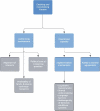Governance systems for skilled health worker migration, their public value and competing priorities: an interpretive scoping review
- PMID: 35037590
- PMCID: PMC8765257
- DOI: 10.1080/16549716.2021.2013600
Governance systems for skilled health worker migration, their public value and competing priorities: an interpretive scoping review
Abstract
Background: Governments worldwide participate in skilled health worker (SHW) migration agreements to protect access to health services in their countries. Previous studies have described the value offered by these agreements in separate source and destination country perspectives.
Objective: We sought to identify and summarise existing literature on shared value creation for both source and destination countries.
Method: We conducted a systematic scoping review of health databases and grey literature. Using Mark Moore and Colin Talbot frameworks, we summarised the public value propositions in migration agreements and how state actors addressed competing priorities.
Results: Most articles (34/63, 53.9%) reported transnational SHW mobility as the public value proposition for source and destination countries. Fewer articles, 14 (22.2%) and 9 (14.3%) articles, respectively, referred to achieving health workforce sustainability and building capacity for SHW migration governance as shared public values. The most identified competing public value (CPV) was an overriding focus on addressing SHW shortages in destination countries (20/63, 37.7%). Efforts to address this CPV include mitigation of the adverse effects of migration (43/63, 68.3%) and promoting health workforce development in source countries (15, 23.8%). At the same time, state actors retained regulatory discretion for protecting their country's public health interest (34, 54%). Most articles reported the lack of funds (15/63, 23.8%) and implementation mechanisms (19/63, 30.2%) as constraints on the authorising environment and the operational capacity of SHW migration governance systems.
Conclusion: Regarding SHW migration governance, the literature reports shared public value propositions for source and destination countries. It also shows how the value-creating process in the management of SHW migration favours destination countries. Future studies will need to explore shared value creation models that ensure equity in the governance of SHW migration.
Keywords: Health workforce; Immigration; emigration; governance.
Conflict of interest statement
KY led this review as part of the requirements for an award of a doctorate at the University of New South Wales, Sydney, Australia. The authors alone are responsible for the views expressed in this publication. These do not necessarily represent the views, decisions, or policies of National Health and Medical Research Council (NHRMC), Australian National Heart Foundation (NHF), University of New South Wales (UNSW) or the Scientia Scholarship board.
Figures





References
-
- Socha-Dietrich K, Dumont J-C. International migration and movement of doctors to and within OECD countries - 2000 to 2018 [cited 2021. Nov 15]. Available from: https://www.oecd-ilibrary.org/content/paper/7ca8643e-en
-
- Trines S. Mobile nurses: trends in international labor migration in the nursing field; 2018. [cited 2021 Sep 21]. Available from: https://wenr.wes.org/2018/03/mobile-nurses-trends-in-international-labor...
Publication types
MeSH terms
LinkOut - more resources
Full Text Sources
